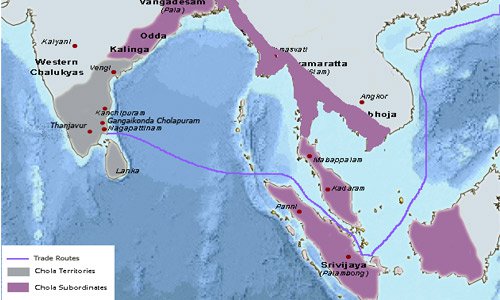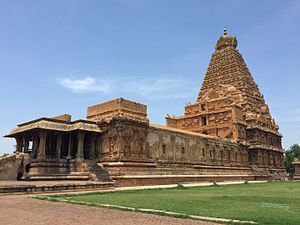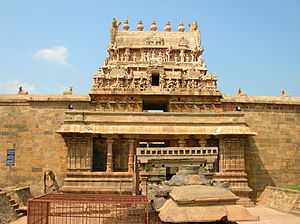-
Chapter 13: IMPERIAL CHOLAS
Introduction
After the end of the Sangam age the Cholas became
feudatories but rose again to prominence in 9 century AD. These
were the years of the Imperial Cholas as they had captured the
entire Malay peninsula and Sri Lanka.
The Cholas ended the Pallava dynasty and also
defeated the Pandya’s but received a setback from the
Rashtrakutas. But under king Rajaraj I they reached the height
of their power.
Kaveri delta was a seat of Chola power.
Features of the reign:
1. The Cholas established supremacy over the Chera and the Pandya under the reign of King Rajaraja I. The Cholas also invaded and captured north Sri Lanka.
2. The Maldives too were captured after military conquest.
3. By defeating the Western Chalukyas of Kalyani the Chola power reached to Tungabhadra river.
4.
The Chola king Rajendra I started a military
campaign against the northern kings and defeated Bengal king.
The Chola kings were devout Shaivites but they were tolerant towards Buddhism and Vaishnavism. The Chola power weakened after successors of Rajendra I and finally the Chola Empire was absorbed into the Pandyan kingdom.

Fig 1: Empire of Imperial Chola
Administration:
1. The king ruled with the help of ministers.
2. The administration was efficient.
3. Surprise visits were made by the king to check efficiency of the administration.
4. Land revenue was collected by elaborately surveying the land. Relief was given during harsh times. The expenditure of taxes was done on canals, irrigation, army, navy, courts.
5. The army and navy were trained in cantonments. The navy was top priority if the Cholas. The navy had dominated both Coromandel and Malabar coasts. In fact the Bay of Bengal was a Chola lake for some period.
6. Village autonomy reached its peak during the Chola rule. Qualifications and disqualifications were prescribed for becoming a member of village committee. These committees had functions and could pass resolutions.
Society:
1. The caste system was prevalent. The upper castes enjoyed special privileges.2. The sub castes too existed but harmonious cooperation existed between them.
3. Women had inferior status. Sati and Devdasi system was prevalent.
4. Temples of Shiv and Vishnu were built. Hence both these sects flourished.
5. Trade with china, Sumatra, Java and Arabs flourished in this period. Silk weaving of Kanchi was famous. Agriculture too increased and forest lands were brought under cultivation.


Fig 2: Great living chola temples Brihadeshwar [Thanjavur] , Airavatesvara Temple and Brihadeshvar [Gangaikonda]
Education:
1. The temples were centers of imparting education.
2. Numerous colleges too were created. In these apart from Vedic knowledge, mathematics and sciences too were taught.
3. Land endowments were given to these.
4. Tamil literature reached its peak during this period.
Art and Architecture:
1. The Vimana style of temple building grew prominent in this period. Walls have detailed frescoes, sculptures, paintings.
2. The temples too were large.
3. The mandaps, and semi mandaps were built in temples.
4. Architectural beauty is also seen in sculptures of large size with fine execution.
5. Chola paintings and bronze statues of dancing girl are famous.
6. Dwarpal and Gana were common in temples. Base of Chola temples has 'Yazhi' – A mythical animal.
7. Bharat natyam was developed.